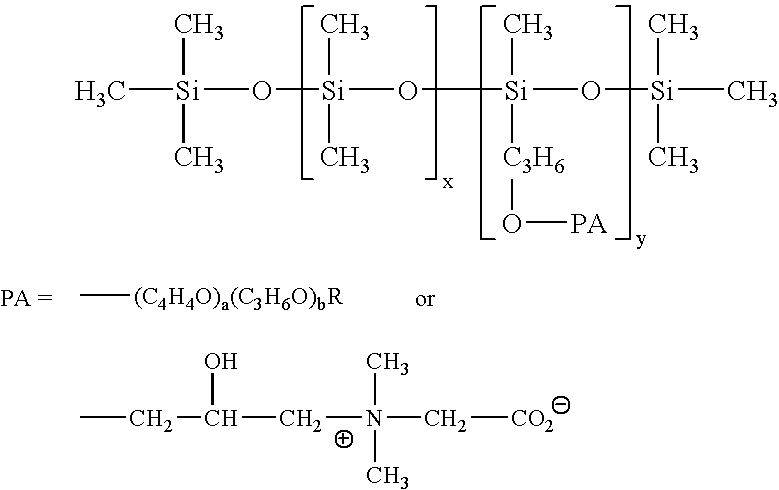Combination of a nonionic silicone surfactant and a nonionic surfactant in a solid block detergent
- Summary
- Abstract
- Description
- Claims
- Application Information
AI Technical Summary
Benefits of technology
Problems solved by technology
Method used
Image
Examples
example i
[0063]
PROTOTYPE FOR TABLE 1The following formula: 12.40%Water 2.5%A nonionic comprising aBenzyl capped, linear C10-14alcohol 12.4 mole ethoxylate 0.5%ABIL ® B 8852 1.572%Defoamer 4.5%Spray-driedaminotrimethylene phosphonicacid, pentasodium salt48.528%Dense Ash (anhydrous Na2CO3) 30%Sodium tripolyphosphate
was extruded from an extruder at a temperature of about 55° C. forming a solid block detergent having a mass of about 3.0 kilograms. The extruder had 2 ingredient ports. In the first port, the dry ingredients including the anhydrous sodium carbonate, the ABIL surfactant, sodium tripolyphosphate, the amino triethylene phosphonic acid sequestrants and ⅔ of the nonionic defoamer material were introduced. In port 2, the liquid ingredients including water, the nonionic, and ⅓ of the nonionic defoamer composition were added. The extruder blended the components into a uniform mass. After exiting the machine the blended mass hardened into a solid block detergent.
example ii
[0064]
3.208%Water 2%A Benzyl capped, linear C10-14alcohol 12.4 mole ethoxylate 2%PLURAFAC ® RA-40 0.5%Silicone (SILWET ® L-7602)1.572%Defoamer4.390%2-phosphono-butane 1,2,4-tricarboxylic acid3.250%NaOH, 50%43.28%Sodium Carbonate (anhy.) 33.5%Sodium tripolyphosphate 6.3%hydroxy propylcellulose-coated (10%) chlorinatedisocyanaurate encapsulate
[0065]Example I was made as a cast solid. Example II and each of the detergents in Table 1 were prepared as a solid block as a prototype by combining the ingredients in the dishwasher without forming a solid. This method simulates the dispensing of a cast solid into the dish machine. The formulation in Example I was used as a basis for the prototypes in Table 1. Example I was repeated as a Prototype I. Prototype II was made by increasing the concentration of the Table 1 listed surfactants. Prototype III was developed by substituting the listed surfactants for the surfactants at the concentration listed in Prototype I, etc. Each test sample wa...
PUM
 Login to View More
Login to View More Abstract
Description
Claims
Application Information
 Login to View More
Login to View More - R&D
- Intellectual Property
- Life Sciences
- Materials
- Tech Scout
- Unparalleled Data Quality
- Higher Quality Content
- 60% Fewer Hallucinations
Browse by: Latest US Patents, China's latest patents, Technical Efficacy Thesaurus, Application Domain, Technology Topic, Popular Technical Reports.
© 2025 PatSnap. All rights reserved.Legal|Privacy policy|Modern Slavery Act Transparency Statement|Sitemap|About US| Contact US: help@patsnap.com



